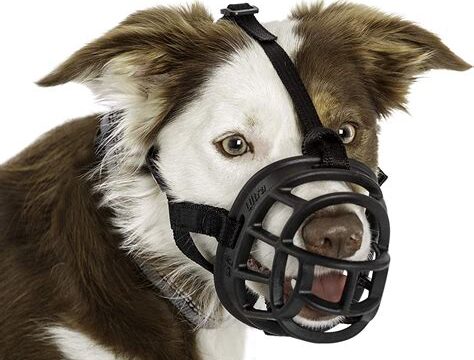Learn how to choose and train the right muzzle for your dog with positive reinforcement and troubleshooting common challenges. Keep your dog comfortable and safe.
Understanding the Need for Muzzling
Many dog owners may have reservations about muzzling their pets, seeing it as a form of punishment or a sign of aggression. However, understanding the need for muzzling is crucial in ensuring the safety of your dog and those around them. Muzzles are not just for aggressive dogs, but can also be used for medical reasons, to prevent biting during grooming or vet visits, or to control scavenging habits during walks. It’s important for dog owners to recognize that muzzling can be a beneficial tool in certain situations, and not a reflection of their dog’s behavior or temperament.
By choosing the right muzzle for your dog and properly introducing it to them, you can help alleviate any stress or discomfort associated with wearing a muzzle. Positive reinforcement plays a key role in muzzle training, as it can help your dog associate the muzzle with positive experiences. Gradually increasing the time your dog wears the muzzle and closely monitoring their comfort and behavior are essential steps in the training process.
Understanding the need for muzzling involves recognizing that it is a responsible and proactive measure to ensure the safety and well-being of your dog and those around them. By approaching muzzle training with patience, consistency, and positive reinforcement, you can help your dog become comfortable wearing a muzzle when necessary, without feeling stigmatized or ostracized.
Choosing the Right Muzzle for Your Dog
Choosing the Right Muzzle for Your Dog
When it comes to choosing a muzzle for your dog, there are several important factors to consider in order to ensure that it is the right fit for your pet. The first thing to consider is the size of your dog’s snout. Different breeds have different snout shapes and sizes, so it’s important to measure your dog’s snout accurately to ensure a proper fit. Additionally, you’ll want to consider the materials used in the construction of the muzzle. Some muzzles are made of leather, while others are made of nylon or mesh. Each type of material has its own advantages and disadvantages, so it’s important to consider your dog’s comfort and the intended use of the muzzle when making your decision.
Another important consideration when choosing a muzzle for your dog is the purpose for which it will be used. Muzzles can be used for a variety of reasons, including preventing your dog from biting or chewing, as well as for grooming or veterinary visits. The intended use of the muzzle will help you determine the style and design that will best suit your dog’s needs. Additionally, you’ll want to consider the adjustability of the muzzle. A properly fitting muzzle should allow your dog to pant, drink, and even take treats while wearing it, so it’s important to choose a muzzle that can be adjusted to ensure a comfortable and secure fit.
Finally, it’s important to consider your dog’s comfort and behavior when choosing a muzzle. Some dogs may be more comfortable with a specific style of muzzle, so it’s important to observe your dog’s behavior and comfort level when trying on different options. Additionally, it’s important to introduce the muzzle to your dog gradually and using positive reinforcement in order to ensure that they have a positive association with wearing the muzzle. By considering these factors and taking the time to find the right fit for your dog, you can ensure that your pet is comfortable and safe when wearing a muzzle.
Introducing Your Dog to the Muzzle
Introducing your dog to the muzzle can be a challenging task, especially if your furry friend is not used to wearing one. It’s important to approach this process with patience and understanding, as it can be a new and potentially uncomfortable experience for your dog.
One of the first steps in introducing your dog to the muzzle is to make sure that they are comfortable with the object itself. Start by allowing your dog to sniff and investigate the muzzle while offering positive reinforcement in the form of treats and praise. This will help your dog associate the muzzle with positive experiences and reduce any anxiety they may have.
Once your dog is comfortable with the muzzle, you can begin to gently introduce it onto their face for short periods of time. Start by securing the muzzle for just a few seconds, then gradually increase the duration as your dog becomes more accustomed to wearing it. Remember to always closely monitor your dog’s comfort and behavior during this process, and be prepared to take breaks or adjust the training as needed.
Positive Reinforcement for Muzzle Training
When it comes to training your dog to wear a muzzle, positive reinforcement is key. It’s important to make the experience as pleasant as possible for your canine companion, so that they don’t develop negative associations with the muzzle. This means using treats, praise, and other rewards to encourage your dog to willingly accept the muzzle.
One effective method of positive reinforcement for muzzle training is to gradually introduce the muzzle to your dog in a non-threatening way. Start by simply placing the muzzle near your dog, allowing them to investigate it at their own pace. Reward them with treats and praise when they show curiosity or tolerance towards the muzzle. This helps to create a positive association with the muzzle as a non-threatening object.
As your dog becomes more comfortable with the presence of the muzzle, you can then start to associate it with positive experiences. For example, give your dog their favorite treat or toy while they are wearing the muzzle, and offer plenty of praise. This helps to reinforce the idea that wearing the muzzle leads to positive outcomes, and can help to reduce any anxiety or discomfort your dog may feel.
Gradually Increasing Muzzle Wearing Time
Gradually Increasing Muzzle Wearing Time
When it comes to training a dog to wear a muzzle, it’s important to take a gradual approach in order to ensure the comfort and cooperation of your furry friend. Forcing a muzzle on your dog too quickly can lead to stress, anxiety, and resistance. By gradually increasing the amount of time your dog wears the muzzle, you can help them acclimate to this new experience in a positive way.
Start by introducing the muzzle to your dog for short periods of time, such as just a few minutes at a time. Use positive reinforcement in the form of treats, toys, or praise to create a positive association with the muzzle. As your dog becomes more comfortable with wearing the muzzle for short durations, gradually increase the length of time they wear it. This slow and steady approach will help your dog feel more at ease with the muzzle and less likely to resist wearing it.
Be sure to monitor your dog’s comfort and behavior throughout this process. If you notice any signs of distress or discomfort, such as pawing at the muzzle, whining, or attempting to remove it, give your dog a break and try again later. It’s important to be patient and understanding as your dog learns to accept the muzzle as part of their routine.
Monitoring Your Dog’s Comfort and Behavior
When it comes to monitoring your dog’s comfort and behavior while wearing a muzzle, it’s important to pay close attention to their physical and emotional response. Keep an eye on any signs of distress, such as excessive pawing at the muzzle, rubbing their face against furniture, or trying to remove the muzzle with their paws. These actions may indicate that the muzzle is causing discomfort or anxiety for your dog.
Additionally, observe their overall behavior while wearing the muzzle. Look for any changes in their body language, such as increased panting, restlessness, or avoidance of certain activities. These could be signals that your dog is feeling stressed or unhappy with the muzzle on. It’s crucial to be attuned to your dog’s communication cues and make adjustments as needed to ensure their well-being.
Regularly check the fit of the muzzle to ensure it remains comfortable for your dog. Make sure it’s not too tight or too loose, and that it allows your dog to pant and drink water freely. If you notice any redness, chafing, or sores on your dog’s skin after wearing the muzzle, it’s important to address these issues promptly and, if necessary, seek guidance from a professional trainer or veterinarian.
Troubleshooting Common Muzzle Training Challenges
When it comes to muzzle training your dog, there may be some common challenges that arise. It’s important to be prepared for these challenges and know how to troubleshoot them effectively.
One common challenge is resistance from your dog. Some dogs may be uncomfortable with wearing a muzzle, and may try to resist putting it on. To troubleshoot this issue, try using positive reinforcement techniques to associate the muzzle with pleasant experiences. Offer treats and praise while gradually introducing and desensitizing your dog to the muzzle.
Another challenge you may encounter is your dog pawing or rubbing at the muzzle. This behavior can be a sign of discomfort or frustration. In this case, it’s important to ensure that the muzzle fits properly and is not causing any irritation. You may need to try different styles or sizes of muzzles to find the right fit for your dog.
Frequently Asked Questions
Why would a dog need to wear a muzzle?
A dog might need to wear a muzzle for safety reasons, such as preventing biting during visits to the vet or groomer, or to prevent scavenging while out on walks.
How can I introduce my dog to wearing a muzzle?
Start by letting your dog sniff and investigate the muzzle, then gradually introduce wearing it for short periods with positive reinforcement, such as treats and praise.
Won’t wearing a muzzle make my dog aggressive?
No, wearing a muzzle does not make a dog aggressive. It is simply a tool to keep both the dog and others safe in certain situations.
Can I leave a muzzle on my dog for long periods?
No, a muzzle should only be worn for short periods of time, such as during visits to the vet or while out in public places where there may be a risk of scavenging.
What type of muzzle is best for my dog?
The best type of muzzle for your dog will depend on their breed, size, and behavior. It’s important to choose a muzzle that allows the dog to pant and drink water while wearing it.
Can I use a muzzle as a substitute for training my dog?
No, a muzzle should not be used as a substitute for proper training and behavior modification. It is a temporary safety measure while working on training and behavior issues.
How do I know if my dog is uncomfortable wearing a muzzle?
Signs of discomfort or distress while wearing a muzzle can include pawing at the muzzle, rubbing their face on the ground, or trying to remove the muzzle with their paws.





